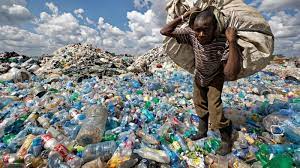BEAT PLASTIC POLLUTION
Nikunja Bihari Sahu
Plastic has been an important part of our daily life ever since it was
synthesized and patented by the Belgian chemist Leo Bakeland in 1907. We daily
wake up to brush our teeth with plastic, bathe with tubs of plastic, drink
water with bottles of plastic and sleep with pillow covers of plastic. Plastic
is easy to mold to different shapes of our choice, cheap and durable and that
is why its popularity in society has been constantly on the rise. Plastic is
primarily manufactured from fossil fuel raw materials like crude petroleum oil
and is chemically a synthetic long-chain polymer. It is needless to say that
the pace and progress of our present civilization is hardly imagined without
plastic.
However, plastic has a very long life span in our biosphere and,
therefore, is not easily biodegradable. Disposal of plastic items in an
eco-friendly manner without causing harm to the environment has created an
enormous challenge for our scientists in recent times. The world plastic
production as of 2019 has been 365 million tons per year with 51% produced in
Asia alone having China as the largest producer of plastic. If the trend
continues, the global annual plastic production will touch the 1100 million
tons mark by 2050 according to one estimate. Of the total world production,
only 9% is recycled and 12% is incinerated and the rest is dumped in nature
causing severe damage to our fragile environment. In developed countries, 50% of the total
plastic production is used in the packaging of items of daily use. Another
devastating dimension of plastic usage is the proliferation of Single Use
Plastic (SUP) items which has been greatly infused into our today's busy
metropolitan lifestyle. These materials such as disposable cups, food trays,
tumblers and spoons are used only once after which they are discarded causing
irreparable damage to nature and natural ecosystems. India produces 3.4 million
tonnes of plastic waste in a year out of which only 30% is recycled. India ranks as the fifth largest
producer of plastic in the world.
The most alarming impact of plastic pollution is in the seas and oceans
of the world. It is estimated that around 8.8 million tons of plastic waste are
dumped into the sea every year by the people living along the coasts. This is
equivalent to the dumping of nearly 1
truckload of plastic garbage into the sea every minute. Isn’t it quite
alarming? These plastic materials broke into fine particles over the years
called ‘microplastic’ that enter into
the marine food chain to eventually make their way to animals like whales,
dolphins, turtles and aquatic birds. It chokes their stomach greatly reducing
their food ingestion ability ultimately leading to their death. Plastic items
like fishing nets also get wrapped around their bodies reducing their mobility
which results in their fate of easily falling prey to the enemies. It is
estimated that nearly 1 lakh sea birds die each year as a result of plastic
pollution of the sea.
Similarly, plastic pollution has also
cast its footprints on the land. Many domestic animals used to eat away plastic
items mistaking them as food that ultimately choke their food path and intestines.
The microplastic materials also enter their bloodstream which causes diseases
like cancer and triggers hormonal imbalances in their bodies leading to retarded growth and reduced cognitive
ability. It is estimated that nearly 1 lakh land animals also die every year as
a result of plastic pollution. Plastic contamination also reduces soil
fertility and affects the water retention capability of the soil. It also
adversely affects the quality of groundwater sources and the process of cloud
formation impacting the rainfall pattern over a region. Plastic materials also
clog the sewage drain systems of a locality thereby amounting incurrence of
vast expenditure annually by the municipal bodies around the world to clear the
blockage.
Since the production of plastic from its source of fossil fuels and its
disposal techniques by incineration amount to the release of vast amounts of
greenhouse gases into the atmosphere, plastic has greatly contributed to global
warming and climate change phenomena over the years. It is estimated that the
carbon emission due to plastic pollution alone will amount to 14% of the total
global emissions by 2050 leading to vast climatic catastrophes.
The way out of the menacing
problem is not far to seek and the message is loud and clear. We should
minimize the consumption of plastic products in our daily life. Instead of
shopping with plastic or polythene bags, we should always carry bags made of
natural fibres like jute or cotton which are biodegradable by nature. The use
of Single-Use Plastic items should be completely banned from public life. Once
the demand for plastic in public life is curtailed, its production will
automatically fall. Scientists should come up with the discovery of new
biodegradable plastic materials which should also be cost-effective and
affordable at the same time to promote its popularity and mass use. New
innovative methods for the disposal of plastic items without affecting nature
should also be explored. Most plastic items should be recycled into new utility
products rather than making them anew from raw materials again. Our mantra
should be Reduce, Recycle and Reuse with a far-reaching goal to diffuse the
ticking away of the plastic bomb and for a transition to a plastic-free society
and eco-friendly lifestyle.
With an aim to create awareness about
the menacing effect of plastic pollution in our daily life and to join hands
for a global campaign of public participation and public partnership in
combating the plastic pollution by providing tangible solutions for a
sustainable future, the theme of the celebration of World Environment Day 2023
has been chosen as 'Beat Plastic Pollution’.
( To read the same article published in The Orissa Post dated 06.06.23, please click the link given below:
http://odishapostepaper.com/m/205751/647ce67c31b89 )
or
https://drive.google.com/file/d/1cWSRLhGS0hX8sFuwyIamLkaibMGckNq9/view?usp=sharing
Education Officer
Regional Science Centre
Bhopal
The Orissa post dated 05.06.25:






Comments
Post a Comment